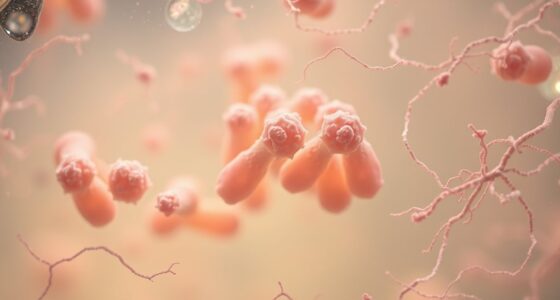Controlled release systems use polymers to control how drugs are delivered over time. These polymers rely on diffusion and degradation processes: drugs pass through the polymer matrix driven by concentration gradients, while gradual breakdown of the material creates new pathways for release. By designing polymers with specific properties, you can tailor the release rate to meet particular needs. Exploring these mechanisms further will give you a deeper understanding of optimizing drug kinetics for various applications.
Key Takeaways
- Polymers control drug release through diffusion and degradation, influencing release rate and duration.
- Degradation mechanisms like hydrolysis create pathways that increase drug permeability over time.
- Diffusion depends on polymer porosity and cross-linking density, affecting how quickly drugs are released.
- The interplay of diffusion and degradation allows precise tailoring of drug release profiles.
- Material properties can be engineered to achieve specific kinetics for sustained or targeted delivery.

Have you ever wondered how some medications or fertilizers deliver their active ingredients steadily over time? The secret lies in the science of controlled release systems, which use specialized polymers to guarantee a gradual, predictable release of substances. When designing these systems, understanding how polymers degrade and how active ingredients diffuse through them is vital. Polymer degradation is a key process that influences the release rate; as the polymer breaks down over time, it allows the embedded active compounds to escape gradually. This degradation can occur via various mechanisms, such as hydrolysis or enzymatic action, depending on the polymer’s composition. As the polymer matrix degrades, it creates pathways that facilitate the diffusion of active molecules, resulting in a continuous and controlled release profile.
Diffusion mechanisms play a central role in controlling how quickly or slowly the active ingredients reach the target site. When a drug or fertilizer is embedded within a polymer matrix, molecules must pass through the polymer’s structure to be released. This movement relies on diffusion, which is driven by concentration gradients. The characteristics of the polymer—such as porosity, cross-linking density, and molecular weight—affect how easily molecules can diffuse. A tightly cross-linked polymer may slow diffusion, prolonging release, while a more porous matrix allows faster diffusion. By fine-tuning these properties, you can design a delivery system that maintains therapeutic levels over days, weeks, or even months.
The interaction between polymer degradation and diffusion mechanisms defines the overall release profile. Initially, diffusion might dominate, with active ingredients slowly migrating through the intact polymer matrix. As the polymer degrades, its structure becomes more permeable, accelerating the release. This synergy allows for precise control: you can manipulate the polymer’s composition to achieve a specific release pattern. For example, selecting biodegradable polymers that undergo hydrolysis enables a predictable degradation timeline, ensuring the active ingredient is released steadily. The combination of degradation and diffusion ensures that the release remains consistent, avoiding the peaks and troughs seen with conventional formulations.
In essence, controlling release through polymers involves a delicate balance of chemical and physical processes. By understanding polymer degradation pathways and diffusion mechanisms, you can craft systems that deliver drugs or nutrients precisely when needed. This approach maximizes effectiveness, minimizes side effects, and improves patient compliance or crop yields. It’s a sophisticated interplay of science and engineering that transforms how we administer medications and fertilizers, making treatments safer, more efficient, and more sustainable over time.
Frequently Asked Questions
How Do Polymers Influence Drug Stability During Release?
Polymers influence drug stability during release through polymer interactions that protect the drug from environmental factors like moisture and enzymes. These interactions form a barrier, preventing degradation and ensuring the drug remains effective until it reaches its target. By carefully designing the polymer matrix, you can enhance drug protection, controlling the release rate and maintaining stability throughout the delivery process. This ultimately improves therapeutic efficacy and patient outcomes.
What Are the Environmental Impacts of Biodegradable Polymers?
You should know that biodegradable polymers reduce environmental footprint by breaking down through natural biodegradation pathways, minimizing pollution. They decompose into harmless substances like water, carbon dioxide, or biomass, which helps protect ecosystems. However, improper disposal or slow biodegradation can still cause environmental harm. Using biodegradable polymers thoughtfully guarantees you support sustainability, reducing waste accumulation and promoting cleaner environments through efficient biodegradation pathways.
Can Controlled Release Systems Be Customized for Individual Patients?
Yes, controlled release systems can be customized for individual patients. You can develop personalized medicine by designing patient-specific formulations that consider unique factors like metabolism, age, and health conditions. This customization guarantees ideal drug release rates and improved therapeutic outcomes. Advances in polymer technology enable you to tailor these systems precisely, making treatments more effective and reducing side effects, ultimately enhancing patient care through personalized medicine.
How Do Temperature and Ph Affect Polymer Degradation Rates?
You might think temperature and pH are minor players, but they actually control polymer degradation rates, often more than you’d expect. Increased temperature accelerates degradation via enhanced polymer crystallinity, making pathways more accessible. Conversely, extreme pH levels can either hasten or slow down degradation pathways, depending on the polymer’s chemistry. So, yes, environmental conditions dramatically influence how quickly your drug release system breaks down, proving nature’s irony in controlling medicine delivery.
What Are the Challenges in Scaling up Controlled Release Manufacturing?
You face several scaling challenges in manufacturing controlled release systems, mainly due to manufacturing complexities. Ensuring consistent polymer quality, controlling drug release profiles, and maintaining product stability become harder at larger scales. Additionally, optimizing process parameters and meeting regulatory standards add to these challenges. You need careful planning, robust quality control, and scalable processes to successfully shift from lab to production, ensuring your controlled release products perform reliably and safely.
Conclusion
Think of controlled release as a skilled conductor guiding a symphony, ensuring each note— or drug— is delivered at just the right moment. With polymers as your baton, you orchestrate a steady, harmonious flow, avoiding chaos and maximizing effectiveness. This delicate dance keeps your patient’s health in perfect tune, turning complex science into a beautiful, reliable melody of healing. Master this art, and you’ll compose solutions that truly stand the test of time.








